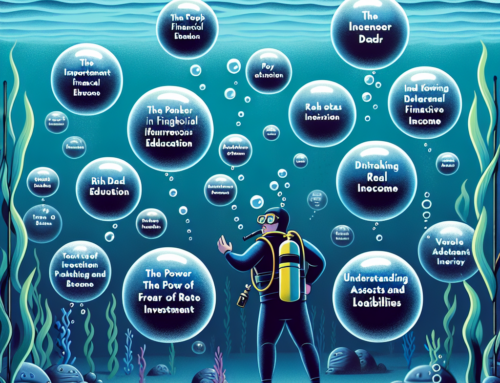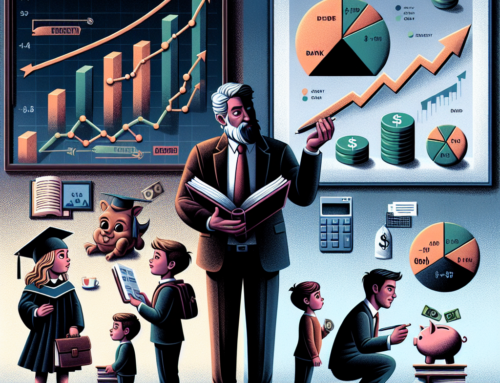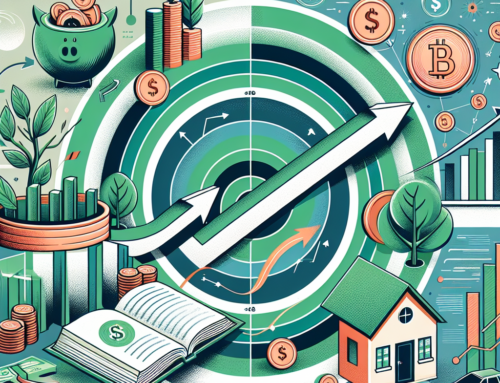
Key Financial Lessons from Rich Dad Poor Dad
”Rich Dad Poor Dad” by Robert Kiyosaki is a seminal work in the realm of personal finance, offering readers a unique perspective on money management and wealth creation. The book juxtaposes the financial philosophies of Kiyosaki’s two father figures: his biological father, whom he refers to as his ”Poor Dad,” and the father of his best friend, whom he calls his ”Rich Dad.” Through this narrative, Kiyosaki distills several key financial lessons that have resonated with millions of readers worldwide.
One of the most fundamental lessons from ”Rich Dad Poor Dad” is the importance of financial education. Kiyosaki emphasizes that traditional schooling often fails to teach students about money, leaving them ill-prepared for real-world financial challenges. He argues that understanding how money works is crucial for achieving financial independence. This lesson is underscored by the contrasting attitudes of his two dads: while Poor Dad believed in the conventional path of getting a good education and a stable job, Rich Dad advocated for financial literacy and entrepreneurial thinking.
Another critical lesson from the book is the distinction between assets and liabilities. Kiyosaki explains that assets are things that put money in your pocket, while liabilities take money out. This simple yet powerful concept is often misunderstood, leading many people to accumulate liabilities thinking they are assets. For instance, a personal residence is commonly perceived as an asset, but Kiyosaki argues that it can be a liability if it drains financial resources. By focusing on acquiring income-generating assets, individuals can build wealth more effectively.
Kiyosaki also delves into the mindset differences between the rich and the poor. He notes that the rich think in terms of opportunities and investments, while the poor often focus on job security and saving money. This mindset shift is crucial for financial success. Rich Dad encouraged Kiyosaki to think like an investor and entrepreneur, seeking out opportunities to grow wealth rather than merely working for a paycheck. This entrepreneurial mindset fosters creativity and resilience, essential traits for navigating the financial landscape.
Moreover, the book highlights the significance of taking risks and learning from failures. Kiyosaki recounts how Rich Dad taught him to embrace failure as a learning opportunity rather than something to be feared. This lesson is particularly relevant in the context of investing and business ventures, where risk is an inherent component. By viewing failures as stepping stones to success, individuals can develop the confidence to pursue their financial goals.
In addition to these lessons, ”Rich Dad Poor Dad” underscores the importance of passive income. Kiyosaki advocates for building streams of passive income through investments in real estate, stocks, and businesses. This approach allows individuals to achieve financial freedom, as they are not solely reliant on their active income from a job. Passive income provides financial security and the freedom to pursue one’s passions and interests.
Furthermore, Kiyosaki stresses the value of continuous learning and self-improvement. He encourages readers to invest in their education, whether through books, seminars, or mentorship. This commitment to lifelong learning is essential for staying ahead in an ever-changing financial landscape.
In conclusion, ”Rich Dad Poor Dad” offers a wealth of financial wisdom that challenges conventional thinking about money and success. By emphasizing financial education, distinguishing between assets and liabilities, adopting an entrepreneurial mindset, embracing risk, building passive income, and committing to continuous learning, Kiyosaki provides readers with a roadmap to financial independence. These lessons, presented in a friendly and accessible manner, make the book a valuable resource for anyone seeking to improve their financial well-being.
The Importance of Financial Education
”Rich Dad Poor Dad” by Robert Kiyosaki is a seminal work that has transformed the way many people think about money and financial education. The book juxtaposes the financial philosophies of Kiyosaki’s two father figures: his biological father, whom he refers to as his ”Poor Dad,” and the father of his best friend, whom he calls his ”Rich Dad.” Through this narrative, Kiyosaki explores the stark differences in mindset and approach to money between the two men, ultimately advocating for the financial strategies and principles of his Rich Dad.
One of the central themes of ”Rich Dad Poor Dad” is the importance of financial education. Kiyosaki argues that traditional education systems do not equip individuals with the necessary skills to manage money effectively. While schools focus on academic and professional skills, they often neglect to teach students how to handle personal finances, invest wisely, or understand the intricacies of the financial world. This gap in education, according to Kiyosaki, leaves many people ill-prepared to achieve financial independence.
To illustrate this point, Kiyosaki shares various lessons he learned from his Rich Dad, who emphasized the importance of financial literacy. For instance, Rich Dad taught him about the difference between assets and liabilities. Kiyosaki explains that assets are things that put money in your pocket, such as investments, rental properties, or businesses, while liabilities are things that take money out of your pocket, like mortgages, car loans, and credit card debt. Understanding this distinction is crucial for building wealth, as it encourages individuals to focus on acquiring assets rather than accumulating liabilities.
Moreover, Kiyosaki highlights the significance of developing multiple streams of income. Unlike his Poor Dad, who relied solely on his salary as a government employee, Rich Dad believed in creating diverse income sources. This approach not only provides financial security but also opens up opportunities for wealth accumulation. Kiyosaki encourages readers to explore various avenues, such as investing in real estate, starting a business, or engaging in stock market investments, to build a robust financial portfolio.
Another key lesson from ”Rich Dad Poor Dad” is the concept of working to learn, not just to earn. Kiyosaki advises readers to seek jobs and opportunities that offer valuable skills and experiences, even if they do not pay well initially. By acquiring knowledge in areas like sales, marketing, accounting, and investing, individuals can enhance their financial acumen and increase their potential for future success. This mindset shift from immediate financial gain to long-term skill development is essential for achieving financial independence.
Furthermore, Kiyosaki emphasizes the importance of taking risks and being proactive in managing one’s finances. He argues that fear and complacency often prevent people from pursuing financial opportunities. By adopting a proactive approach and being willing to take calculated risks, individuals can overcome these barriers and work towards financial freedom. Kiyosaki’s own experiences, including his successes and failures, serve as a testament to the value of perseverance and resilience in the face of financial challenges.
In conclusion, ”Rich Dad Poor Dad” by Robert Kiyosaki underscores the critical role of financial education in achieving financial independence. Through the contrasting philosophies of his two father figures, Kiyosaki provides valuable insights into the importance of financial literacy, the distinction between assets and liabilities, the benefits of multiple income streams, the value of skill development, and the necessity of taking risks. By embracing these principles, readers can better navigate the complexities of the financial world and work towards a more secure and prosperous future.
Understanding Assets and Liabilities
”Rich Dad Poor Dad” by Robert Kiyosaki is a seminal work in the realm of personal finance, offering readers a fresh perspective on wealth-building and financial independence. One of the book’s core teachings revolves around understanding the difference between assets and liabilities, a concept that Kiyosaki argues is fundamental to achieving financial success. This distinction, while seemingly straightforward, is often misunderstood, leading many individuals to make financial decisions that hinder rather than help their economic growth.
Kiyosaki introduces the concept through the contrasting financial philosophies of his two ”dads”—his biological father, whom he refers to as his ”Poor Dad,” and the father of his best friend, whom he calls his ”Rich Dad.” His Poor Dad, despite being well-educated and holding a stable job, struggled financially due to his conventional approach to money. In contrast, his Rich Dad, who had a less formal education but a keen understanding of financial principles, amassed significant wealth by focusing on acquiring assets and minimizing liabilities.
To delve deeper into this concept, Kiyosaki defines assets as things that put money in your pocket, while liabilities are things that take money out of your pocket. This simple yet profound definition challenges the traditional view that owning a home, for example, is always an asset. Kiyosaki argues that if a home requires continuous expenses such as mortgage payments, maintenance, and taxes without generating income, it should be considered a liability. This perspective encourages readers to critically evaluate their financial decisions and prioritize investments that generate positive cash flow.
Transitioning from theory to practice, Kiyosaki emphasizes the importance of financial literacy in identifying and acquiring assets. He suggests that individuals educate themselves on various investment opportunities, such as real estate, stocks, bonds, and businesses. By doing so, they can make informed decisions that align with their financial goals. Kiyosaki also highlights the significance of passive income—money earned with minimal effort—through investments that appreciate over time or generate regular returns.
Moreover, Kiyosaki’s approach to assets and liabilities extends beyond tangible investments. He encourages readers to invest in their education and skills, viewing knowledge and expertise as invaluable assets that can open doors to new opportunities and income streams. This holistic view of assets underscores the importance of continuous learning and personal development in the journey toward financial independence.
In addition to acquiring assets, Kiyosaki advises readers to be mindful of their spending habits and avoid accumulating liabilities. He cautions against lifestyle inflation—the tendency to increase spending as income rises—and advocates for living below one’s means. By maintaining a frugal lifestyle and focusing on building a robust portfolio of income-generating assets, individuals can create a solid financial foundation that withstands economic fluctuations.
In conclusion, ”Rich Dad Poor Dad” offers a transformative perspective on personal finance by elucidating the critical difference between assets and liabilities. Kiyosaki’s insights challenge conventional wisdom and encourage readers to adopt a proactive approach to wealth-building. By prioritizing financial education, making informed investment decisions, and maintaining disciplined spending habits, individuals can pave the way to financial independence and long-term prosperity. This comprehensive understanding of assets and liabilities is not just a lesson in finance but a roadmap to a more secure and fulfilling financial future.
The Role of Mindset in Achieving Financial Success
”Rich Dad Poor Dad” by Robert Kiyosaki is a seminal work that has influenced countless individuals in their pursuit of financial independence. One of the book’s most compelling themes is the role of mindset in achieving financial success. Kiyosaki contrasts the differing attitudes and beliefs of his ”Rich Dad” and ”Poor Dad,” illustrating how these mindsets shape their financial destinies. This comparison serves as a powerful narrative device, making the abstract concept of mindset tangible and relatable.
Kiyosaki’s ”Poor Dad,” his biological father, represents the conventional wisdom about money and career. He is highly educated, works hard, and believes in the security of a steady job. Despite his intelligence and dedication, he struggles financially, living paycheck to paycheck. This is not due to a lack of effort or ability but rather a mindset that prioritizes job security over financial independence. His belief system is rooted in the idea that a good education and a stable job are the keys to financial success. However, this mindset often leads to a cycle of earning and spending without accumulating wealth.
In contrast, Kiyosaki’s ”Rich Dad,” his best friend’s father, embodies a different approach to money and work. He is less formally educated but possesses a keen understanding of how money works. Rich Dad’s mindset is entrepreneurial; he sees opportunities where others see obstacles and is willing to take calculated risks. He emphasizes the importance of financial education, investing, and building assets that generate passive income. This mindset allows him to achieve financial freedom, demonstrating that wealth is not solely the result of hard work but also of smart financial strategies and a proactive attitude.
The book underscores that mindset is not just about positive thinking but involves a fundamental shift in how one views money and opportunities. For instance, Rich Dad teaches Kiyosaki to ask, ”How can I afford it?” instead of saying, ”I can’t afford it.” This subtle change in phrasing encourages creative problem-solving and opens the door to new possibilities. It shifts the focus from limitations to potential, fostering a mindset that is geared towards growth and innovation.
Moreover, Kiyosaki introduces the concept of financial literacy as a crucial component of a wealth-building mindset. He argues that traditional education systems fail to teach students about money management, investing, and entrepreneurship. As a result, many people are ill-equipped to handle financial challenges and miss out on opportunities to build wealth. By educating oneself about financial principles and staying informed about economic trends, individuals can make more informed decisions and take control of their financial futures.
The book also highlights the importance of overcoming fear and doubt, which are often the biggest barriers to financial success. Rich Dad advises Kiyosaki to embrace failure as a learning experience rather than a setback. This mindset encourages resilience and adaptability, qualities that are essential for navigating the uncertainties of the financial world. By viewing failures as opportunities for growth, individuals can develop the confidence to pursue their financial goals with determination and persistence.
In conclusion, ”Rich Dad Poor Dad” by Robert Kiyosaki offers valuable insights into the role of mindset in achieving financial success. Through the contrasting examples of his two fathers, Kiyosaki illustrates how attitudes and beliefs about money can significantly impact one’s financial trajectory. By adopting a proactive, entrepreneurial mindset and prioritizing financial education, individuals can break free from the constraints of conventional wisdom and pave their own paths to financial independence. The book serves as a reminder that while hard work is important, the right mindset is the true key to unlocking financial success.
How to Build and Grow Passive Income Streams
”Rich Dad Poor Dad” by Robert Kiyosaki is a seminal work that has inspired countless individuals to rethink their approach to money and wealth. One of the book’s most compelling aspects is its focus on building and growing passive income streams. This concept is crucial for anyone looking to achieve financial independence and long-term wealth. In this article, we will explore how Kiyosaki’s principles can help you create and expand your passive income sources.
To begin with, Kiyosaki emphasizes the importance of financial education. He argues that traditional schooling often fails to teach students about money management, investing, and the creation of passive income. Instead, it focuses on preparing individuals for a life of employment, where they trade time for money. Kiyosaki’s ”Rich Dad” taught him that true financial freedom comes from understanding how money works and making it work for you. This foundational knowledge is the first step in building passive income streams.
One of the primary ways to generate passive income, according to Kiyosaki, is through real estate investments. Real estate can provide a steady stream of rental income while also appreciating in value over time. Kiyosaki advises starting small, perhaps with a single rental property, and gradually expanding your portfolio. He also stresses the importance of due diligence, such as researching the market, understanding property values, and being aware of potential risks. By carefully selecting properties and managing them effectively, you can create a reliable source of passive income.
Another avenue for passive income that Kiyosaki discusses is investing in stocks and bonds. While this may seem daunting to beginners, Kiyosaki breaks it down into manageable steps. He suggests starting with index funds or mutual funds, which offer diversification and lower risk compared to individual stocks. Over time, as you become more comfortable and knowledgeable, you can explore other investment opportunities, such as dividend-paying stocks. The key is to reinvest your earnings, allowing your investments to grow exponentially through the power of compound interest.
In addition to real estate and stock market investments, Kiyosaki highlights the potential of creating intellectual property. This could be anything from writing a book to developing a software application. Once created, these assets can generate income with minimal ongoing effort. For instance, an author can earn royalties from book sales for years after the initial publication. Similarly, a software developer can continue to profit from their application long after it has been released. The initial effort required to create these assets can be substantial, but the long-term rewards can be significant.
Kiyosaki also underscores the importance of entrepreneurship in building passive income streams. Starting your own business can be a powerful way to create wealth, especially if you can develop a business model that doesn’t require your constant involvement. For example, franchising or creating an online business can allow you to earn money even when you’re not actively working. The goal is to build systems and processes that enable the business to run smoothly without your direct input.
In conclusion, ”Rich Dad Poor Dad” offers invaluable insights into building and growing passive income streams. By focusing on financial education, real estate investments, stock market opportunities, intellectual property, and entrepreneurship, you can create multiple sources of income that work for you. Kiyosaki’s principles provide a roadmap for achieving financial independence and long-term wealth, empowering you to take control of your financial future.
We have lots of exciting coming events in Entrepreneurship, Investing and Personal Development. You can find them all here:
www.swedishwealthinstitute.se/events




